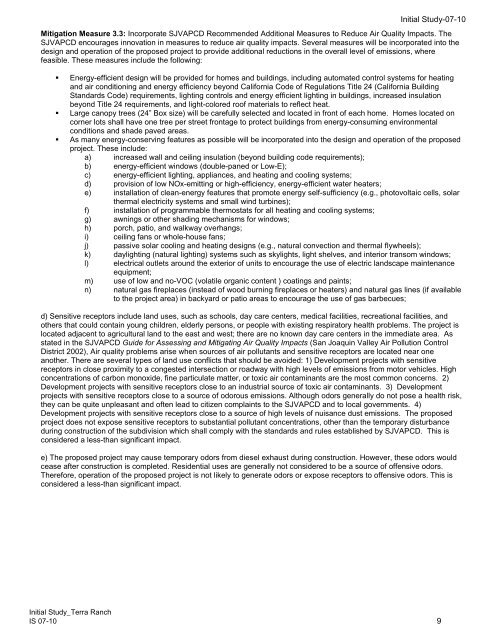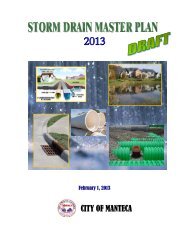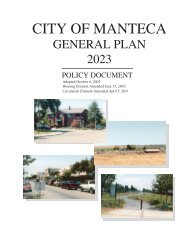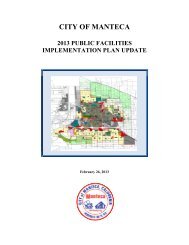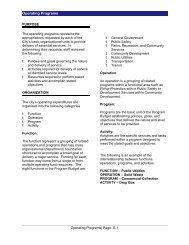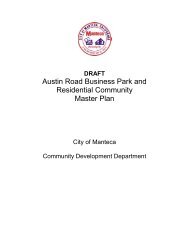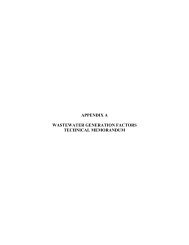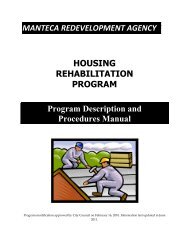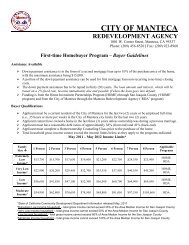NOTICE OF PREPARATION - City of Manteca
NOTICE OF PREPARATION - City of Manteca
NOTICE OF PREPARATION - City of Manteca
Create successful ePaper yourself
Turn your PDF publications into a flip-book with our unique Google optimized e-Paper software.
Initial Study-07-10<br />
Mitigation Measure 3.3: Incorporate SJVAPCD Recommended Additional Measures to Reduce Air Quality Impacts. The<br />
SJVAPCD encourages innovation in measures to reduce air quality impacts. Several measures will be incorporated into the<br />
design and operation <strong>of</strong> the proposed project to provide additional reductions in the overall level <strong>of</strong> emissions, where<br />
feasible. These measures include the following:<br />
Energy-efficient design will be provided for homes and buildings, including automated control systems for heating<br />
and air conditioning and energy efficiency beyond California Code <strong>of</strong> Regulations Title 24 (California Building<br />
Standards Code) requirements, lighting controls and energy efficient lighting in buildings, increased insulation<br />
beyond Title 24 requirements, and light-colored ro<strong>of</strong> materials to reflect heat.<br />
Large canopy trees (24” Box size) will be carefully selected and located in front <strong>of</strong> each home. Homes located on<br />
corner lots shall have one tree per street frontage to protect buildings from energy-consuming environmental<br />
conditions and shade paved areas.<br />
As many energy-conserving features as possible will be incorporated into the design and operation <strong>of</strong> the proposed<br />
project. These include:<br />
a) increased wall and ceiling insulation (beyond building code requirements);<br />
b) energy-efficient windows (double-paned or Low-E);<br />
c) energy-efficient lighting, appliances, and heating and cooling systems;<br />
d) provision <strong>of</strong> low NOx-emitting or high-efficiency, energy-efficient water heaters;<br />
e) installation <strong>of</strong> clean-energy features that promote energy self-sufficiency (e.g., photovoltaic cells, solar<br />
thermal electricity systems and small wind turbines);<br />
f) installation <strong>of</strong> programmable thermostats for all heating and cooling systems;<br />
g) awnings or other shading mechanisms for windows;<br />
h) porch, patio, and walkway overhangs;<br />
i) ceiling fans or whole-house fans;<br />
j) passive solar cooling and heating designs (e.g., natural convection and thermal flywheels);<br />
k) daylighting (natural lighting) systems such as skylights, light shelves, and interior transom windows;<br />
l) electrical outlets around the exterior <strong>of</strong> units to encourage the use <strong>of</strong> electric landscape maintenance<br />
equipment;<br />
m) use <strong>of</strong> low and no-VOC (volatile organic content ) coatings and paints;<br />
n) natural gas fireplaces (instead <strong>of</strong> wood burning fireplaces or heaters) and natural gas lines (if available<br />
to the project area) in backyard or patio areas to encourage the use <strong>of</strong> gas barbecues;<br />
d) Sensitive receptors include land uses, such as schools, day care centers, medical facilities, recreational facilities, and<br />
others that could contain young children, elderly persons, or people with existing respiratory health problems. The project is<br />
located adjacent to agricultural land to the east and west; there are no known day care centers in the immediate area. As<br />
stated in the SJVAPCD Guide for Assessing and Mitigating Air Quality Impacts (San Joaquin Valley Air Pollution Control<br />
District 2002), Air quality problems arise when sources <strong>of</strong> air pollutants and sensitive receptors are located near one<br />
another. There are several types <strong>of</strong> land use conflicts that should be avoided: 1) Development projects with sensitive<br />
receptors in close proximity to a congested intersection or roadway with high levels <strong>of</strong> emissions from motor vehicles. High<br />
concentrations <strong>of</strong> carbon monoxide, fine particulate matter, or toxic air contaminants are the most common concerns. 2)<br />
Development projects with sensitive receptors close to an industrial source <strong>of</strong> toxic air contaminants. 3) Development<br />
projects with sensitive receptors close to a source <strong>of</strong> odorous emissions. Although odors generally do not pose a health risk,<br />
they can be quite unpleasant and <strong>of</strong>ten lead to citizen complaints to the SJVAPCD and to local governments. 4)<br />
Development projects with sensitive receptors close to a source <strong>of</strong> high levels <strong>of</strong> nuisance dust emissions. The proposed<br />
project does not expose sensitive receptors to substantial pollutant concentrations, other than the temporary disturbance<br />
during construction <strong>of</strong> the subdivision which shall comply with the standards and rules established by SJVAPCD. This is<br />
considered a less-than significant impact.<br />
e) The proposed project may cause temporary odors from diesel exhaust during construction. However, these odors would<br />
cease after construction is completed. Residential uses are generally not considered to be a source <strong>of</strong> <strong>of</strong>fensive odors.<br />
Therefore, operation <strong>of</strong> the proposed project is not likely to generate odors or expose receptors to <strong>of</strong>fensive odors. This is<br />
considered a less-than significant impact.<br />
Initial Study_Terra Ranch<br />
IS 07-10 9


